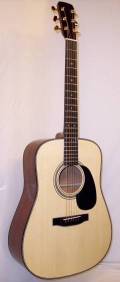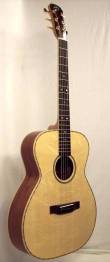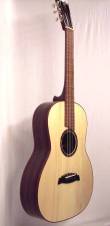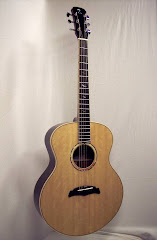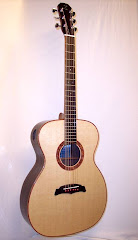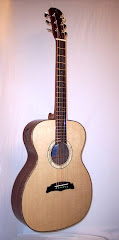a bit remiss in updating this blog. I have been crazy busy and just haven't had any time to work on the guitar this last week other than spending some time profiling the rims to the needed width, and then sanding them on the radius dishes. I am waiting on a couple of parts to arrive, but really that isn't holding me up. What is holding me us is work and online book selling. It has just been crazy. Hopefully I will get some shop time this weekend. I also have a small cheap classical guitar that my daughter's friend asked me to do some minor repairs on. It really is a piece of ...... well you know what.... but it gives me a little repair experience. Unfortunately the neck is very much out of alignment and it has a Spanish heal. I have no experience at all with them and I won't even attempt to re-set it. Fortunately I can make a new saddle, level the frets and get the action back down to a playable level instead of about a mile above the frets like it is now. It is a garage sale special so really no harm....no foul on this one. The girl who owns it can't play and just wants it cleaned up, new strings, and fix some chips. I figure if I can get it playable that is better than it is now.
Sorry, no pictures tonight.
Wednesday, January 16, 2008
Monday, January 7, 2008
Glued in blocks.....
I didn't have a lot of shop time today but I did get the neck block finished and both glued to the rims. I also got the back and top sanded down to thickness. The top is .122" now and I figure I will have it down to .115 for final thickness, and the back is sanded to .085". I went down to .075" on the twins and it felt like I went a bit thin on them. They are solid, but they can be bowed back without too much effort so I wanted to stiffen this one up a touch. I went a lot by feel on both the top and back this time. I did a lot of flexing, especially of the top to get a feel for stiffness. When I felt the top starting to loosen up, I stopped sanding.
Sunday, January 6, 2008
Making blocks...
Today I decided to make the neck and tail blocks for the 0. This is when I realized that I didn't really have any wood to do this with. Well, that really isn't true, I just didn't have the wood that I was accustomed to using. After digging around in my scrap box, I was able to scrounge up a piece of Sapele neck wood that will make a nice neck block, and I have lots of 1"x6" mahogany planking that is suitable for the tail block. I was able to cut a single piece tail block, but the neck block was a touch too short for the overall length I need. Not a big deal as I have had to shim pretty much every neck block I have made so far. I glued up the neck block to a shim and set it aside to dry. I then shaped the curve of the tail block and knocked the edges. Typically I have cut the edges with a 45 degree angle. While that looks fine and works, I decided that I wanted to dress this one up a bit so I grabbed a decorative router bit and knocked the corners with that. I like how it looks and I think I will continue to do that in the future. It is purely a decorative touch, one that almost nobody will ever see but I like it.
I spent some time making a base for my laminate trimmer that I got for Christmas that can be used for binding channel routing. I made it out of Lexan and basically it makes a thin 'shoe' that rides along the very edge of the guitar. There is a roller bearing that rolls along the side. The reason for the shoe is that with the angle of the back and top radiuses, there are some spots that the guitar will 'tip' while routing on a router table. This requires some clean up of the channels because those tipping spots will cause the channel to be narrower than required. I decided that I want to get better with my bindings and although they look good now, anyone with a keen eye or ruler will quickly realize that they are not perfectly uniform all the way around the guitar. I want to improve this aspect of my guitar building.

First off, here is the air filtration unit I put in the shop. It seems to work quite well as the filter already looks dirty and I really haven't done much dusty work.

Here is the neck block glued up and clamped. The shim on top is significantly larger than needed. The block was actually only about 1/8" short.

Here is the binding unit for my laminate trimmer. The bearing on the bit keeps the bit the proper distance for cutting depth, and the bottom bearing is completely adjustable both in and out, and up and down. If you look closely you can see the narrow shelf I attached which will ride on the top or back. In theory this should work well. :)

It just dawned on my that I never posted a picture of the finished Troji. I got some 2" foam rubber for padding and glued it in. I then sanded the edges and then I gave the whole thing 2 coats of poly and called it done. Here you can see one of my finished guitars being used as a Guinea pig for testing. It works great. It holds the guitar very securely without putting much pressure at all on it.
I spent some time making a base for my laminate trimmer that I got for Christmas that can be used for binding channel routing. I made it out of Lexan and basically it makes a thin 'shoe' that rides along the very edge of the guitar. There is a roller bearing that rolls along the side. The reason for the shoe is that with the angle of the back and top radiuses, there are some spots that the guitar will 'tip' while routing on a router table. This requires some clean up of the channels because those tipping spots will cause the channel to be narrower than required. I decided that I want to get better with my bindings and although they look good now, anyone with a keen eye or ruler will quickly realize that they are not perfectly uniform all the way around the guitar. I want to improve this aspect of my guitar building.

First off, here is the air filtration unit I put in the shop. It seems to work quite well as the filter already looks dirty and I really haven't done much dusty work.

Here is the neck block glued up and clamped. The shim on top is significantly larger than needed. The block was actually only about 1/8" short.

Here is the binding unit for my laminate trimmer. The bearing on the bit keeps the bit the proper distance for cutting depth, and the bottom bearing is completely adjustable both in and out, and up and down. If you look closely you can see the narrow shelf I attached which will ride on the top or back. In theory this should work well. :)

It just dawned on my that I never posted a picture of the finished Troji. I got some 2" foam rubber for padding and glued it in. I then sanded the edges and then I gave the whole thing 2 coats of poly and called it done. Here you can see one of my finished guitars being used as a Guinea pig for testing. It works great. It holds the guitar very securely without putting much pressure at all on it.
Saturday, January 5, 2008
Vacation is over....
...and it's time to get back to work building guitars. If you remember, I am going to build a 12 fret size 0 redwood and striped Honduran mahogany. In December I joined the top and back plates and built the bender mold, but didn't do anything else as I was pre-occupied with the twins. Today was the day to bend the sides. I was a bit nervous about this bend as the wood is highly figured striped mahogany and as such, it has a great tendency to want to crack or have the grain separate. I did a lot of research on the most reliable way to bend it and got to work. A couple of days ago I thinned the sides down to .075" thickness and then spritzed them with SuperSoft 2. I let them dry for a couple of days so the wood was ready. I wrapped the sides in kraft paper that was lightly spritzed with distilled water so there was some moisture to help the bend by allowing steam to penetrate, but not enough to get the wood wet. There is some mixed opinions on bending mahogany. Some say to bend it wet and hot, yet others say bend it dry, fast, and hot. I decided to go towards that dry, fast and hot method. I got the wood up to 295 degrees and started the bend. Everything went well and much to my delight, both sides came out beautifully. This was some expensive wood so I wasn't too thrilled at the idea of ruining a set of sides and ending up with an orphan back. I cut the sides to length and clamped them in the side mold. Next up will be making and gluing in the neck and tail blocks.
I received my shop air cleaner on Thursday and got it installed in the shop. I hung it directly over the table saw with the input facing the sanding and routing area. My thinking is I want the dust to be pulled up into the unit as quickly as possible. The unit is very quiet and it seems to be effective according to my highly scientific testing. I took a handful of saw dust and threw it in the air in front of the input. The dust was quickly drawn in and trapped by the filter. I forgot to take a picture today but I will tomorrow.

This is the second side after being bent. I had to shorten the base of my bender a little bit because the parlor size mold is so much shorter than the other sizes I have built.

One of the sides just out of the bender. Note all of the oil that has penetrated the paper. It is a lot easier to toss some dirty paper than it is to clean up the bending slats!

There was one section of one side where the wood grain separated a little bit. You can see it here as black horizontal lines on the left side. Fortunately that was the only spot that this happened, and it is well outside the profile area so it is no problem. The cracks are however all the way through and I can see light through them if I hold the sided up to a window. I am very glad this didn't happen in the middle of the side!
I received my shop air cleaner on Thursday and got it installed in the shop. I hung it directly over the table saw with the input facing the sanding and routing area. My thinking is I want the dust to be pulled up into the unit as quickly as possible. The unit is very quiet and it seems to be effective according to my highly scientific testing. I took a handful of saw dust and threw it in the air in front of the input. The dust was quickly drawn in and trapped by the filter. I forgot to take a picture today but I will tomorrow.

This is the second side after being bent. I had to shorten the base of my bender a little bit because the parlor size mold is so much shorter than the other sizes I have built.

One of the sides just out of the bender. Note all of the oil that has penetrated the paper. It is a lot easier to toss some dirty paper than it is to clean up the bending slats!

There was one section of one side where the wood grain separated a little bit. You can see it here as black horizontal lines on the left side. Fortunately that was the only spot that this happened, and it is well outside the profile area so it is no problem. The cracks are however all the way through and I can see light through them if I hold the sided up to a window. I am very glad this didn't happen in the middle of the side!
Subscribe to:
Posts (Atom)







